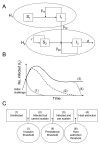Community epidemiology framework for classifying disease threats
- PMID: 16485464
- PMCID: PMC3367628
- DOI: 10.3201/eid1112.050306
Community epidemiology framework for classifying disease threats
Abstract
Recent evidence suggests that most parasites can infect multiple host species and that these are primarily responsible for emerging infectious disease outbreaks in humans and wildlife. However, the ecologic and evolutionary factors that constrain or facilitate such emergences are poorly understood. We propose a conceptual framework based on the pathogen's between- and within-species transmission rates to describe possible configurations of a multihost-pathogen community that may lead to disease emergence. We establish 3 dynamic thresholds separating 4 classes of disease outcomes, spillover, apparent multi-host, true multihost, and potential emerging infectious disease; describe possible disease emergence scenarios; outline the population dynamics of each case; and clarify existing terminology. We highlight the utility of this framework with examples of disease threats in human and wildlife populations, showing how it allows us to understand which ecologic factors affect disease emergence and predict the impact of host shifts in a range of disease systems.
Figures



References
Publication types
MeSH terms
LinkOut - more resources
Full Text Sources
Other Literature Sources
